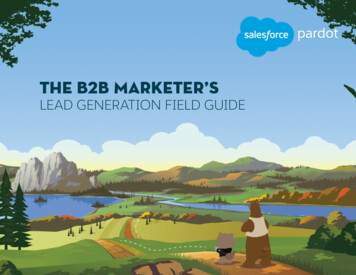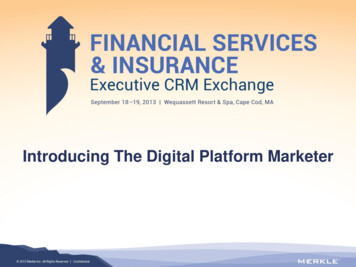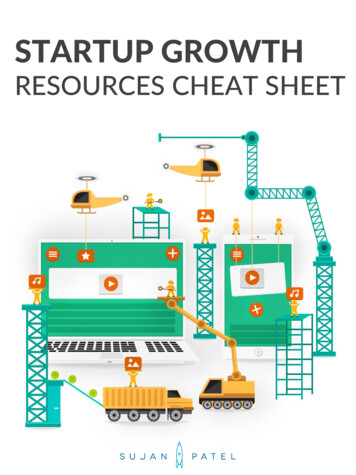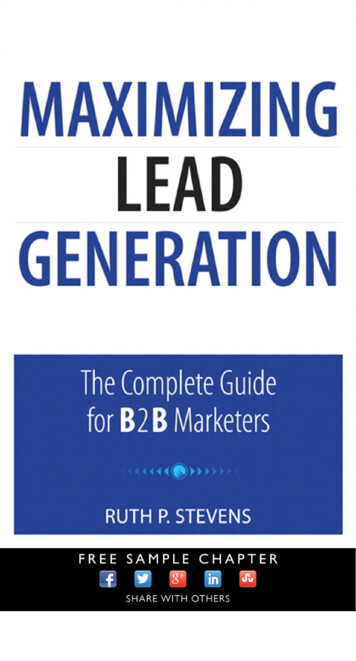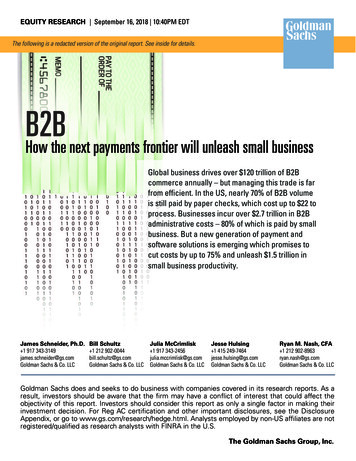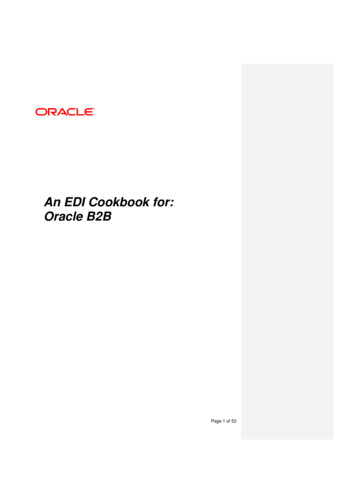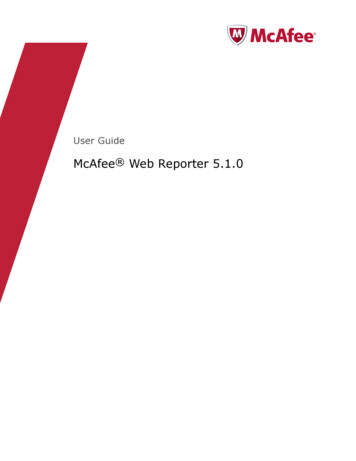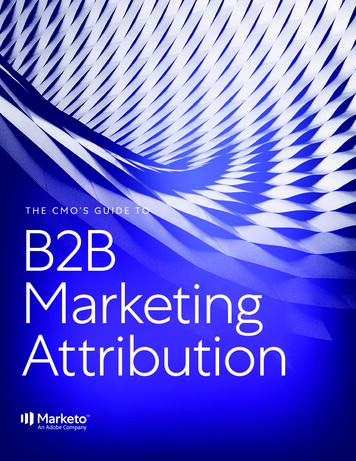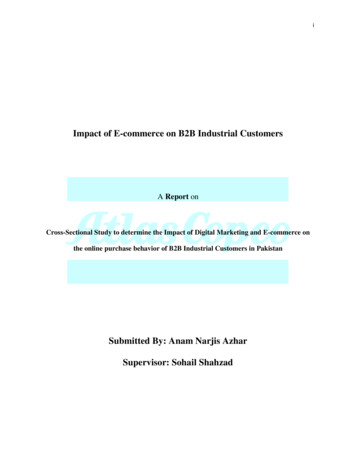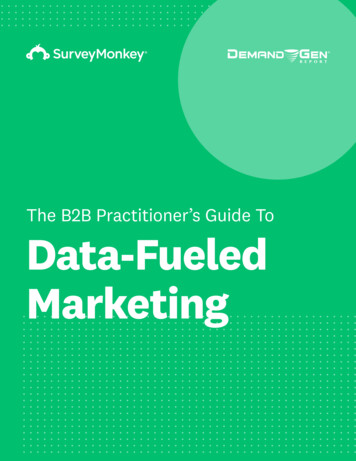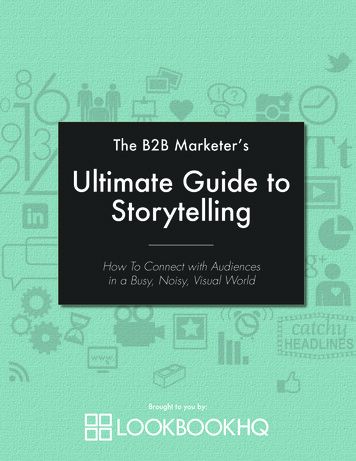
Transcription
The B2B Marketer’sUltimate Guide toStorytellingHow To Connect with Audiencesin a Busy, Noisy, Visual WorldBrought to you by:1
The PrologueEvery story needs a set-upAre you sitting comfortably?Then I’ll begin.Why is storytelling a hot topic for B2B marketers atthe moment?In his book “Tell to Win”, Peter Guber argues thathumans simply aren’t moved to action by “datadumps” and wordy PowerPoint slides, rather byemotion, hence we need to tell stories. And JonathanGottschall in his book “The Storytelling Animal”further argues that science backs up the long-heldbelief that story is the most powerful means ofcommunicating a message:The short answer is simple. Everyone loves a goodstory. We’re conditioned to respond to stories fromthe cradle onwards. And your business audience isundoubtedly no exception.Becoming a better marketing storyteller is harder thanit might seem at first. Should B2B marketers try to tellbetter stories? What makes a good B2B story?“Until recently we’ve only been able to speculateabout story’s persuasive effects. But over the lastseveral decades psychology has begun a seriousstudy of how story affects the human mind. Resultsrepeatedly show that our attitudes, fears, hopes,and values are strongly influenced by story. In fact,fiction seems to be more effective at changing beliefsthan writing that is specifically designed to persuadethrough argument and evidence.” (JonathanGottschall for FastCo. Create)Good stories are understandable, memorable andrepeatable; bad ones are none of those things.To paraphrase Chip Heath and Dan Heath intheir excellent book “Made To Stick”, we can allremember urban myths such as the Kidney Heist butstruggle terribly to remember, let alone retell, anyof the salient points from, say, that presentation yousat through yesterday or that report you read lastThursday.Why do stories work? Because according to theresearch it appears that we drop our intellectual2
defenses and engage with stories in a different waythan with other types of content such as productspecification sheets. Stories, to use Guber’s centralmetaphor, are Trojan Horses:“The audience accepts the story because, for ahuman, a good story always seems like a gift.But the story is actually just a delivery system forthe teller’s agenda. A story is a trick for sneakinga message into the fortified citadel of the humanmind.” (Jonathan Gottschall for FastCo. Create)Why should B2B marketers care about storytelling?Because we’re learning that they are the ultimatemarketing message delivery system – or as Gottschallputs it, “storytelling is a uniquely powerful form ofpersuasive jujitsu”. Who doesn’t want a black beltin persuasion? B2B marketers want to tell storiesbecause we’re looking to deliver our messages –“We’re the best!”, “We know what we’re talkingabout!”, “Buy our product or service!” and themyriad of far more subtle variants – in a manner thatwill hit home and ultimately achieve the objective.Booo!Enter “The Villains”.BUSY,NOISY& VISUAL3
But unfortunately in the B2B worldthere’s rarely a spot on anyone’scalendar marked “StorytellingTime” (if only!).tellingStor y etimReaching your audience is going tobe hard.As a B2B Marketer trying to tell your story to youraudience you need to contend with 3 key factors:Your Audience Is BusyYour Space Is NoisyYou know this. You’re busy so it would makesense that they are as well. But I’m not sureanyone realizes just how busy they are.There are an awful lot of companies andbrands competing for your audience’sattention. The Futures Company, the consumerinsights company and publisher of the YankelovichMONITOR, estimates that “we’ve gone from beingexposed to about 500 ads per day in the 1970s toas many as 5,000 a day today”. And that was inearly 2009. Some people are now estimating thatwith today’s technology advances this figure may beas high as 30,000 messages per day. Regardlessof the number though, it’s clear that as Jay WalkerSmith, Executive Chairman of The Futures Company,puts it in a CBS article on “Cutting ThroughAdvertising Clutter”: “Everywhere we turn we’resaturated with advertising messages trying to get ourattention.”A recent study from LexisNexis on workplaceproductivity amongst white collar professionals paintsa bleak picture:- They spend over half of their day (51%) justreceiving and managing information, rather thanactually using information to do their job (in the US,this is a 10% increase since 2008).- 62% admit that the quality of their work suffersbecause they can’t sort the information they needquickly enough.- 51% believe they are almost at “breaking point”,at which they will be unable to handle any moreinformation.So you need to stand out. Quick, produce morecontent! But then your competitors do too! Soyou need to produce even more content! So yourcompetitors do too! Aaaaaahhhhh. Welcome to yourB2B Marketing Vicious Cycle.Ouch. The B2B audience is really busy, somethingto bear in mind next time you want them to read a20-odd page White Paper or eBook (like this one.Sorry ).4
The World Is (Increasingly) Visual(Okay, maybe ‘visual’ isn’t a villain like‘busy’ and ‘noisy’ – visual can in fact beenormously useful when you’re trying to tella story. But it certainly needs to be considered whenyou’re thinking storytelling in 2013. Consider thischaracterization dramatic license!)“The world is (increasingly) visual”. That’s a bit of adumb statement: the world has always been visual.But the online world hasn’t been, it’s been text-based.That’s changing quickly - and some.Pinterest is the fastest company to 10m monthlyunique users ever. Twitter has launched Cardsto introduce a visual element to 140 charactercommunication and enabled services such as Vine.YouTube is reporting stellar growth - 1 billion monthlyactive users. Infographics - the good and the (manymore) bad - are all the rage and the humble gif ismore popular than ever (who knew?).A picture is indeed worth a thousand words it wouldappear. And this makes sense as the brain “makesmeaning by seeing, by an act of visual interrogation”according to leading information designer TomWujec at a TED Talk in 2009 (“3 ways the braincreates meaning”). He states the lessons for us arethreefold:1) Use images to clarify ideas.2) Interact with images to create engagement.3) Augment memory with persistent & evolving views.Oh yeah.People don’t read online.5
How do people read online? According to seminalresearch from the Neilsen Norman Group, they don’tand never have (at least not since 1997).Or perhaps more accurately, they scan - until theyfind the things that they want to read (assumingthat they do indeed find something they want toread). The Neilsen Norman Group has concludedthat, “users will read about 20% of the text on theaverage page”.That means they’re not reading 80% of what youwrite. That’s 80% of your website, 80% of yourblog posts, 80% of your whitepapers and eBooks.Although you may never know this because thisparticular section is part of the 80% of this eBookthat you didn’t read Even the Brothers Grimm would havetheir work cut out for them as B2BMarketers.On the face of it that’s a pretty bleak backdrop fora B2B marketer trying to tell their story today. Youraudience is busy, your space is noisy, the world isincreasingly visual and, to boot, people don’t read.How do peopleread online?And chances are you’re trying to market a product orservice that on the face of it doesn’t appear to lenditself to storytelling particularly well. That could, darewe say it, be considered “unsexy” and maybe even“boring”.They Don’t.But as the adage goes, there’s no such thing as abad story, only a bad storyteller. And how doesa bad storyteller become a good storyteller? ThiseBook is certainly a good place to start. In thecourse of our extensive research on B2B storytelling,we’ve identified 8 key things that B2B marketersneed to consider when telling stories to theiraudience. We’ve also identified B2B companiesthat are doing each of these points well and seededthese examples throughout forinspiration.But enough introduction! We’vegot our villains of this piece –Busy, Noisy and Visual – whatabout our heroes?Here they come, enteringstage right 6
The PlotIn which our heroes save the daySo what are the key things that B2B marketers need toconsider when it comes to storytelling?In the following sections we will cover our 8 key things that B2Bmarketers need to consider when telling stories to their audience:1. Understand your audience2. Give them catchy headlines AND depth3. Text visuals good - but multimedia better4. Avoid the slow reveal5. Be concrete6. Aim for an emotional response - or at the very least a laugh7. Drive action8. Measure your story’s impactUnderstand your audienceThere’s a reason this is No. 1 on our list.It’s the Very Important Point here.Think about: To whom are you telling your story? Is there a tone, voice or language that theyexpect or like to hear? Are there particular content formats that workwith them? Where do you expect them to be when theyengage with your story - e.g. at their desks,out and about, post work, at the weekend,etc.? What are their concerns and pain points?If you can’t answer these questions before you startputting your story together, you’re going to need to.Your Customer or Buyer Personas should be somehelp here. And there’s presumably nothing to stopyou from asking your customers what type of storiesthey like.Who does this well?7
JOHN DEERE Because John Deere’s 2012 product line wasdesigned by actual customers, the product launchfeatured their customers as much as it did theirequipment. From live events, webcasts, websites,videos, print ads, banner ads, even marquees onthe Vegas strip — these customers were alwayscenter stage. Their “You’re On” campaign states:“This is about giving you a greater voice. Withinour company and throughout our industry”. In the words of Gyro, John Deere’s marketingconsultancy: “Our strategy for the entire launchwas focused one simple principle: Lead with thecustomer. We never cast a spotlight on a machine by itself. The equipment took a backseat tothe customers who designed it and the relationship the company enjoys with those customers.” Their marketing is ostensibly blue collar workerstalking to blue collar workers in their own words– and enormously powerful as a result.RUBY Ruby, the virtual receptionist service provider,understands that their customers are buying nota service per se but people who will be the firstpoint of contact for their companies. As a result,they need to project “friendliness, charm, can-doattitude, and professionalism” in everything theydo from your first engagement with them as apossible Ruby customer. Their entire marketing and web presence (e.g.their blog – “The Watercooler”) is focused ontheir culture and their people, so that you – theaudience – gain the peace of mind that you andyour customers are in excellent hands.8
Give them catchy headlines AND depthWe’ve established your audience is busyand your space is noisy.So how do you grab people’s attention?everyone is a content machine and publisher”. Thisadvice is routinely given to mean that B2B shouldpublish more and more content. But we think itmeans something else, namely that you shoulddeliver your stories and content like a newsroom.How does a newsroom deliver the news? See ourBBC example. They do it brilliantly, combiningsuccinct headlines with depth, which explains whythey’ve been able to translate their offline successand reputation online as well.You write awesome headlines - keep them short andrelevant to direct their attention where it should be.Let them know what they’re getting with your content.But this is B2B - your audience needs depth, not justcatchy headlines. Better still, they need layers ofdepth so they can engage at the level they need to.For some, the headline may be enough - rememberthat they scan in the first instance. For others, they’regoing to need to go a level below. They may readthe executive summary, a paragraph or two, asection, or the whole report.There are a lot of people advising B2B marketersto act like newsrooms as, to paraphrase, “nowWho does this well?THE BBC No one writes engaging headlines as consistently well as the BBC. Typically they are 5 or 6words that tell you succinctly what the story isabout. They make it easy to scan the news stories andchoose where you want to engage. And onceyou’re in a story, they tell you the most importantinformation upfront in the first paragraph – the“executive summary” in B2B parlance. Then, ifyou want to read more, you can read the restof the story. Want to go deeper still? Then you’llbe interested in the “More on this story” at thebottom of the article containing links to furtherrelevant information.9
iQ INTEL It’s no surprise that iQ Intel looks more like theBBC news app than a standard corporate website. They’re delivering content like a newsroom. Like the BBC, iQ Intel curates content and giveseach piece a great headline, a good summaryand related content recommendations. The objectives for iQ Intel when it launched inbeta in May 2012 were threefold: 1) create across device storytelling experience; 2) take thepulse of the web and 3) build a media propertyto integrate paid, owned and earned media.We’d say they’ve achieved all 3.Text visuals good - but multimedia betterUsing visuals to complement yournarrative is not a new technique.But we think there’s more to it than this. A recentreport from PR Newswire on “Press Releases as LeadGenerators” analyzed the success of 10,000 pressreleases and their results are fascinating:a range of different content types - e.g. video forthe customer case study, interactive chart to showperformance vs. competitors, PDF for the productspec, etc. Adding a photo to a press release resulted in a14% response increase (over text-only releases)The more interesting takeaway is that combiningthem and delivering them in a single packagegets great results and better engagement. Are youcombining these currently? How? You need to finda way to package these different content typestogether into a coherent story, just like the mostsuccessful press releases in the PR Newswire study.And then you need to share them so you’re notentirely reliant on people coming to wherever it isyou’ve assembled this story (e.g. your blog). Adding a video, 20% response increase Adding both photo and video, 48% responseincrease Adding photo, video plus additional documentssuch as PDF, Word or PowerPoint files, a 77%response increaseThe takeaway for B2B storytellers? Multimedia getsgood engagement. But then you probably alreadyknow this. That’s why you’re telling your story acrossWho does this well?10
PRAXIS Praxis – a small patient recruitment organizationspecializing in finding patients for medicalresearch studies – wanted to grow its businessin the pharmaceutical sector. Working with theiragency, Crowley Webb, they identified 5,000primary sales targets – people that were decisionmakers regarding the outsourcing of patientstudies. Rather than writing a whitepaper or the likestressing the benefits of Praxis relative to theircompetitors, they went a different route. Theyspoke directly to prospects with oversized directmail posters, album covers, video games, moviesand cookies – and six foot ficus trees (illustratingthat with Praxis a pharma company’s studysubjects could grow on trees ). Praxis told a coherent story consistently, visuallyand engagingly using a whole host of differentcontent types. And the campaign worked – theygrew their business significantly and are nowworking with some of the world’s leading pharmabrands.BOOKYOURSELFSOLID Copyblogger is well known in B2B marketingcircles as a go-to-resource for excellent marketingtips and guidance. One of their authors, MichaelPort, a bestselling author of 4 books, explainedin a recent post why he had to make a visualedition of his book “Book Yourself Solid” –because people don’t read. As Port explains: “For example, in the original,it took me 20 pages to teach you how tocreate an information product. In Book YourselfSolid ILLUSTRATED, I do it with 5 images. Ofcourse, I still offer some supporting text, but thecombination of those two learning tools — textand visuals — helps you retain what you’velearned so you actually use it.”11
Avoid the slow reveal!If you’re anything like us (and youraudience certainly is), it’s the exceptionrather than the rule that we make itthe whole way through most onlinepresentations or videos.This is because there’s inherently a “slow reveal”aspect to online presentations and videos as peoplebuild their case to reach their conclusions. As aresult, we can’t easily scan it to get to the pointswe find interesting and useful and we lose interest,as our attention span isn’t that great (and is in factdecreasing).Steve Ballmer, Microsoft’s CEO and, one wouldassume, a PowerPoint champion, commented on theslow reveal problem in an interview with the NewYork Times in 2010. Ballmer criticized the “longand winding road” of slide decks and presentations.He commented that he doesn’t like to be on thereceiving end of them, nor does he think thisapproach is “productive” or “efficient”.Sure, there are good, sometimes excellent slidedecks out there - the most popular presentationson SlideShare are routinely interesting. And there’salways a time and a place for a good slide deck.But there’s an awful lot of bad decks out there too– decks that don’t hold the attention, decks that arebasically clicked through without stopping (if indeedthey are lucky enough to get someone to the end).If anyone is to blame for “slow reveal” ennui it’sthe author rather than the medium per se. Strategyconsultancies such as McKinsey and Bain, forexample, typically structure presentations accordingto Barbara Minto’s Pyramid Principle, whereby onepresents one’s conclusions first to avoid the “slowreveal” and each headline point is supported bysubsequent points in a pyramid structure. Maybewe should take a leaf out of their book and tell ourstories backwards? Or think of alternative ways andformats in which to tell our story that avoid the slowreveal.Who does this well?I decided that’s not what I want to do anymore. Idon’t think it’s productive. I don’t think it’s efficient.I get impatient. So most meetings nowadays, yousend me the materials and I read them in advance.And I can come in and say: “I’ve got the followingfour questions. Please don’t present the deck.”-Steve Ballmer, Microsoft CEO12
INFOGRAPHICS Infographics have been all the rage for a coupleof years now. Why? Well, making informationvisual is certainly a key part of their appeal.But infographics also allow a reader to skimthe graphic and decide where they want toengage. There is no slow reveal inherent to aninfographics.BARBARAMINTO PYRAMIDPRINCIPLE(and Strategy Consultancies the world over) “The Minto Pyramid Principle says that yourthinking will be easy for a reader to grasp if youpresent the ideas organized as a pyramid undera single point.” The single point is the A – the Answer – in aSCQA framework – where S Situation, C Complication and Q Question. Because your presentation leads with the Answer,there’s no slow reveal, only supporting pieces ofinformation that validate your Answer.13
Be concretePeople struggle with the abstract.And B2B business topics can certainlybe abstract, particularly B2B technologyproducts and services.product to your customers 48 hrs faster than now(and everyone can get Friday afternoons off duringthe summer)”.Big Data, for example, THE buzzword of 2012 –what does that actually mean to anyone who isn’t adata scientist? Probably very little, maybe somethingto do with Twitter’s “Firehose” ?!Making the abstract concrete is about focusing onthe results and impacts of the abstract. What doesthis mean to someone in his or her normal, everydaylife? There doesn’t need to be a highfalutin conceptor Three Letter Acronym (TLA) in sight.The only way to enable people to relate to theabstract is to make things concrete for them. Forexample, to make the abstract Big Data concreteyou could explain the tangible impact that Big Datacould have on them or their business such as “itwill increase your profits by 20% in 18 months” or,perhaps better still, “it will allow you to deliver yourWho does this well?IBM(with OgilvyOne) How do you make predictive analysis concrete?In 2011 IBM applied it to tennis matches atWimbledon in real-time to show people thesuccess of IBM’s predictive analysis engine. That’sreally putting your money where your mouth is. As part of the campaign, the audience wasasked a question: if IBM can predict the outcomeof a tennis match, what it could do for yourbusiness? “This campaign combined an innovativeintegration of IBM’s analytics capabilities with anexciting creative approach. Delivering it via theExec Channel screens provided a highly targetedway of reaching our business audience. Andthe research shows that it was both efficient andeffective, so we will be continuing to evolve thisapproach for Wimbledon in 2012” RosemaryBrown, IBM UK Brand Advertising Manager14
CISCO Cisco’s “My Networked Life” is a “documentarystyle video series that takes you around theworld for a look at how young professionals,entrepreneurs, artists and students are usingconnected technology to achieve goals andrealize dreams. These stories are personal, theyare real and they are powerful. #networkedlife” Part of “The Network”, Cisco’s Technology NewsSite, there’s not a product spec in sight. Insteadthe emphasis both in My Networked Life andin The Network in general is on the impact thattechnology can have on people’s lives. Articleslike “How Technology Lets Consumers TrackProducts” makes the technology RFID relevantand understandable by relating it to Europe’srecent horsemeat scandal.Aim for an emotional response - or at the very least a laughYou’re looking to make a connection with Consider:your audience - and the best connections What about your founder’s stories?are always emotional. How do you, your products or services helppeople? What are your staff’s stories? Whatwonderful and extraordinary things have theydone? What are your customers’ stories? How didthey get here? What does the world look like for youraudience without your company?There’s a reason people remember urbanmyths - they often involve an emotionalreaction.There’s a great study from Upshot and BrainJuicer thatproves that emotion has a place in B2B marketing.They sought to affect the emotional state of theiraudience before asking them to rate a new product.They saw significantly higher purchase intent fromthe inspired (vs. depressed) group and concluded:“Effective B2B marketing should affect the target’semotions while delivering its selling message”.Alright, hands up if you’re probably thinking “Ha,easier said than done! How do I make [insert slightlydry, abstract product or service] emotional?!” Maybeit’s not obvious where the emotion is in your businessbut it’s there.Emotional connections have the added benefitof humanizing your business, which is importantbecause, when all is said and done, people buyfrom people. There’s an old adage in sales that“people buy on emotion and justify by logic”. Yourbusiness needs a human face to help generate anemotional connection with your audience.Or you could just make them laugh. Which could beharder!15Who does this well?
CHARITIES It’s not B2B but nobody does emotion inmarketing better than charities. Ann Handley at Marketing Profs has highlightedUnicef’s effective use of Pinterest. Unicef’sPinterest board shows what Ami Musa, a 13year old from Sierra Leone, wants – grain, cleanwater, soap, an education, shoes. Things werather take for granted in the First World.DOMTAR We’re told that the world is going paperless –which means Domtar, the paper manufacturer,would appear to have its work cut out. It’s marketing campaign “Paper Because” is(in our opinion) nothing short of brilliant. Their“really, really short films” shine a light on theimportant roles that paper plays in all of our lives– the waiter who doesn’t write down the ordergets it completely wrong, the husband who sendshis wife an eCard for their anniversary ends updining alone (“Honey, where are you going? Didyou check your spam folder?”), fortunately there’sa gift receipt for the rather ugly vase the brideto-be receives at her shower and an awkwardmoment passes. And what do you do if you’re Domtar at SXSW,the tech world’s leading event? You obviouslycreate a Paper Hotspot area complete withcomfortable sofas, books, sketch books, etc.Inspired. The Paper Because campaign is about more thanvideo – it extends across a series of articles onthe role of paper in our lives (e.g. “Bringing inthe mail is one of the few things we all still havein common”).16
BYTESDOCUMENTSOLUTION We had to feature this because it made us laugh.How do you make Managed Print Servicesinteresting and humorous? Meet Printerman – thepersonification of all our frustrations, trials andtribulations that we’ve suffered at the hands ofprinters. As they explain: “Paper jams, low toner, andunknown errors are typical clues that Printermanhas visited your office. You may be a victim.Act NOW. Do not approach him. Whenprovoked he is known to squirt toner over peopleand ruin their clothes. He’s a menace to everyoffice worker. Already this year his victims haveincluded Personal Assistants, IT professionals,Executives, Sales & Marketing people and H.R.People. YOU could be next.”Drive actionGood stories frequently contain a“takeaway”.Fairytales teach good behaviour (“stay true andyou’ll be alright in the end!”), urban myths containwarnings (“never get into this situation!”). Charitiesare all about the ‘donate now’ call to action (afterthey’ve generated an emotional response).Assuming we’re doing more than brand awareness,B2B marketers also typically want our audience totake action - register for our webinar, check out ourproduct demo, speak to a member of the sales team.Your Call To Action (“CTA”) needs to be explicit - butnot jarring. How do we achieve this?One option is to structure your narrative deductivelyso that you lead your audience through your storywith lots of “therefores” and “this is whys” so thatregistering for your webinar seems like the onlypossible sensible conclusion.Another is to replicate the architecture that NancyDuarte brilliantly identifies as being common to greatpresentations. Great presentations, she explains,frequently move between explaining “what is” and“what could be” with as large a gap between themas possible. Make the status quo and the normalunappealing so that your audience wants to act onyour CTA to achieve the “what could be” - the “newbliss”. Who doesn’t want some more bliss in theirlife? Where do I sign?17Who does this well?
KASPERSKYLAB Kasperky Lab, a top four IT security company,launched its “Be Ready for What’s Next”campaign to boost market awareness, increasesales and launch its Endpoint 8 security product.It was intended as “rallying cry” for IT decisionmakers looking to seize business opportunity andmanage risk. The campaign involved a significant volumeof content of different types – infographics,animations, research reports, white papers,technical product collateral and thoughtleadership pieces. The campaign was primarily educational andcreated a framework for its audience withinwhich decisions could be made and acted upon.And it was very successful: the campaign drew aEuropean audience of more than 18.5m throughprint media and over 157m through onlinecoverage – and generated a pipeline of 29m.YOTTAA Yottaa sells website optimization software. Itdrives action by performing an analysis on awebsite of your choice for free and providing adetailed report on where it ranks and how youcan improve your site’s performance. Whenyou see that your Yottaa score is only 27/100,you’re keen to engage with Yottaa to see howyou can make it better (if you’re anything like usanyway)! Yottaa also gives you the context to understandwhy improving your score is important – forexample: “When doing business on the Web,every millisecond counts. A delay of 1 secondin page load time can result in 7% loss inconversions, 11% fewer pageviews and a 16%decrease in customer satisfaction. The typicalonline shopper expects your pages to load in 2seconds or less. After 3 seconds, up to 40% willabandon your site.”18
Measure your story’s impactRight, you’ve told your story.Did it work?How do we tell the story better next time?Like anything we do as B2B marketers, we shouldknow if it’s providing a return on the effort that weput into it.Is this something that can be measured? It certainlycan be if you break the story across different piecesof content - engagement with the specific pieces ofcontent can be tracked and measured. There arealso useful tools to measure particular content types- e.g. Vidyard provides powerful metrics regardingvideo consumption. And of course, there’s no reasonnot to A/B test a story.If your story contains a CTA, then conversions perthat CTA are the most obvious way to measure it.100 people engaged with our story, 12 peopleacted on the CTA.But as we’ve seen, storytelling is complicated andinvolves many different parts. How do we tell whichparts of it are working? If we were to change a partof it, would 32 people have acted on the CTA?Who does this well?How do we tell the story better next time?Is this something that can be measured?2e2 2e2’s submission to B2BMarketing.Net’s 2012Awards clearly explains the success of theirBusiness Architectures project run with Purestone:“The results have been exceptional, returninginvestment 166 times. Segmentation of the60,000-strong customer database gave rise tokey insights to drive eCRM campaigns, deliveringunique open rates of 28 per cent. Click throughrates of more th
you’re thinking storytelling in 2013. Consider this characterization dramatic license!) “The world is (increasingly) visual”. That’s a bit of a dumb statement: the world has always been visual. But the online world hasn’t been, it’s been text-based. That’s changing quickly -
